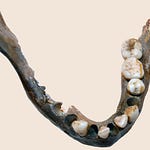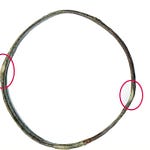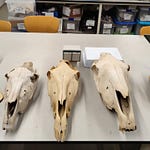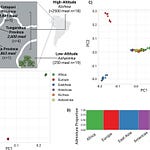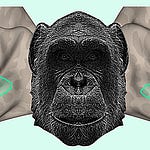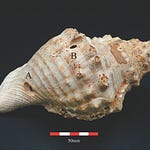In the hills west of modern Seville, archaeologists recently1 unearthed an object with no local origin and a story that spans ecosystems. Inside a circular pit beneath the Valencina Copper Age mega-site—a sprawling 3rd millennium BCE settlement once home to monumental tombs and thousands of buried offerings—researchers discovered half of a sperm whale tooth, intentionally placed and strikingly preserved.
At first glance, the tooth might seem anomalous: a deep-sea object far from shore, fragmented by human hands, buried in a structured context with no human remains. But the Valencina tooth is not just a fossilized curiosity. It offers a rare glimpse into how prehistoric communities engaged with distant environments, powerful animals, and symbolic materials, even when those materials were half a continent away from their source.
From Deep Sea to Sacred Soil
The sperm whale (Physeter macrocephalus) tooth was found in 2018 in the Nueva Biblioteca sector of the Valencina site. At 13.2 centimeters long and weighing over 400 grams, it represents only the upper half of the original tooth. Analysis suggests the tooth belonged to a large adult male whale, most likely deceased from natural causes.
Before humans ever laid hands on it, the tooth had already traveled a great distance—ecologically if not geographically. Bioerosion marks show that it spent considerable time on the seafloor, colonized by sponges and bored through by marine mollusks and barnacles. Shark bite marks suggest scavenging. Eventually, the tooth was dislodged—perhaps by tides or storms—and washed up on a coastal shore.
Some time after this marine journey, the tooth came into human hands. Microscopic grooves and striations at its base suggest people used tools—possibly chisels—to segment it. But instead of crafting it into an ornament or tool, they buried it in a conical pit along with domestic animal bones, stone tools, and pottery fragments.
"The bioerosion tells a story of the sea; the anthropic marks tell a story of intent," observed lead author Dr. Samuel Ramírez-Cruzado Aguilar-Galindo. "Together, they point to an object that was not only collected but chosen—possibly revered."
Not a Trophy, Not a Tool
What makes this find exceptional is not simply its rarity—though it is the first sperm whale tooth ever discovered in a prehistoric Iberian context and only the second in the western Mediterranean. Rather, it is the way the tooth was used—or deliberately not used.
There are no other cetacean remains at the site. There’s no evidence that the people of Valencina hunted whales, nor that they systematically exploited stranded carcasses. The anthropic alterations to the tooth suggest it was intentionally fractured, possibly to obtain ivory, but no tools or ornaments made from sperm whale ivory have been recovered from the site.
Instead, the pit in which it was deposited seems to have been used for a singular event. It contained no human remains. The materials found alongside the tooth—decorated pottery, burned animal bones, and unusually drilled ceramic fragments—point toward a form of structured deposition, or votive offering.
"We believe the deposition was ceremonial in nature," the authors wrote. "This was not waste disposal or tool caching. It was a symbolic act."
A Whale in the Copper Age Imagination
To understand the significance of this act, one must consider the broader cultural setting of Copper Age Iberia. Valencina is no ordinary settlement. It spans nearly 450 hectares and includes large tholos tombs, monumental ditches, and thousands of pits used for both ritual and domestic purposes. Its inhabitants buried their elite with elephant tusks, ostrich eggshells, rock crystal, and elaborate gold ornaments. Long-distance exchange networks linked them to faraway regions, from the Portuguese Atlantic to North Africa.
Marine materials occasionally appear in ritual contexts—Pecten maximus shells, for instance, were used as burial offerings and architectural embellishments in several tombs. But the whale tooth stands out for its size, its distant origin, and the care with which it was deposited.
"It’s not just the material that matters," says the research team. "It’s the story embedded in the material—the animal it came from, the environments it passed through, and the cultural meaning it accrued."
In this sense, the tooth is a powerful example of what archaeologists call object biographies: the idea that objects carry histories, not just functions. They move, change, and gather meaning as they pass through different hands, environments, and symbolic systems.
A Symbolic Leviathan
The researchers draw comparisons to a similarly dated sperm whale tooth from Monte d’Accoddi, a ritual complex in Sardinia. Both specimens were unassociated with other marine remains and both show evidence of human modification. This suggests that coastal communities in the western Mediterranean may have shared conceptual frameworks for engaging with large marine mammals, not merely as subsistence resources but as meaningful others—agents of myth, perhaps, or symbols of power.
There’s no direct evidence that Neolithic Iberians had stories about whales. But like the aurochs and elephant, whose remains are often found in high-status burials, the whale may have occupied a liminal role: immense, rare, and otherworldly.
Social Memory in Deep Time
Perhaps the most remarkable feature of the Valencina whale tooth is its placement. The pit was filled deliberately, in a single episode. Its contents—animal remains, ceramic fragments, grinding stones, and the tooth—form a curated collection. They were not dumped, but arranged.
This suggests that the tooth was not only valued as a rare item, but may have been understood as carrying social or cosmological meaning. It may have been a relic, a talisman, or a totem. Or perhaps it was an object of ancestral memory—a fragment of a story passed down along maritime trade routes or preserved in the material culture of distant coasts.
What Comes Next?
While no DNA could be extracted from the tooth due to poor collagen preservation, its contextual associations and morphological traits provide rich data. The researchers call for further interdisciplinary studies on marine ivory, structured deposition, and symbolic uses of animal remains in Copper Age Europe.
They also suggest reexamining museum collections for overlooked marine mammal remains and encourage more detailed sourcing of ivory artifacts, especially those whose species origin is ambiguous.
A Window to the Copper Age Cosmos
In the end, the sperm whale tooth from Valencina is more than a novelty. It is a window into how ancient societies related to distant animals and landscapes, how they valued rarity and strangeness, and how they folded the wide world—ocean depths included—into their ritual and symbolic systems.
"This object invites us to imagine a world where the sea was not a boundary, but a source of meaning. The whale’s tooth, gathered from the surf and buried in sacred earth, may have bridged not only ecosystems, but cosmologies."
Related Research
Schuhmacher, T., Banerjee, A., Dindorf, W., Sastri, C., & Sauvage, T. (2013). The use of sperm whale ivory in Chalcolithic Portugal. Trabajos de Prehistoria, 70, 185–203. https://doi.org/10.3989/tp.2013.12109
Melis, M. G., & Zedda, M. (2021). Sperm whales in the Neolithic Mediterranean: A tooth from the sanctuary of Monte d’Accoddi (Sardinia, Italy). Antiquity, 95. https://doi.org/10.15184/aqy.2020.213
Zilhão, J., Monge Soares, A., & Pereira Gonçalves, A. (2022). Sperm-whale V-perforated buttons from Galeria da Cisterna (Portugal). Trabajos de Prehistoria, 79, 131–140.
Lefebvre, A. et al. (2021). Interconnected Magdalenian societies as revealed by the circulation of whale bone artefacts in the Pyreneo-Cantabrian region. Quaternary Science Reviews, 251, 106692. https://doi.org/10.1016/j.quascirev.2020.106692
García Sanjuán, L., Luciañez Triviño, M., & Cintas-Peña, M. (2018). Ivory, elites and lineages in Copper Age Iberia: exploring the wider significance of the Montelirio tomb. Madrider Mitteilungen, 59, 23–65.
Ramírez-Cruzado Aguilar-Galindo, S., Luciañez-Triviño, M., Muñiz Guinea, F., Cáceres Puro, L. M., Toscano Grande, A., Díaz-Guardamino, M., Vargas Jiménez, J. M., Schuhmacher, T. X., Martínez Sánchez, R. M., Guillamón Dávila, S., Rodríguez Vidal, J., & García Sanjuán, L. (2025). From the jaws of the “Leviathan”: A sperm whale tooth from the Valencina Copper Age Megasite. PloS One, 20(5), e0323773. https://doi.org/10.1371/journal.pone.0323773




